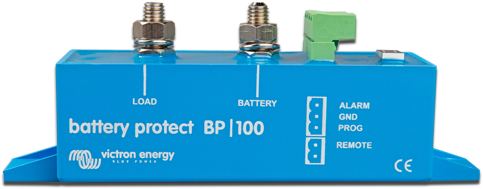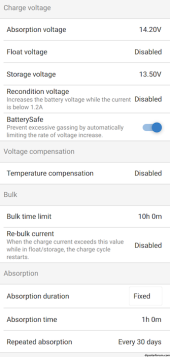I have an AmpereTime 12V 50Ah battery that I intend to use as a DIY UPS to power some 12V network gear. My plan is to keep it simple, and just have fused 12V leads from the battery feeding the loads and a Victron BlueSmart IP65 charger plugged into the wall to keep the battery charged. I will be several days travel away from this configuration once it is installed, so reliability and safety is important.
However, I'd like to ensure that the battery is cycled to about 40% SoC, and to only charge to 90%. I know that I am risking a situation where the battery is at a relatively low SoC when needed, but I'm accepting that risk.
To achieve this, my plan is to configure the Victron BlueSmart charger with the following settings:
Absorption Voltage: 13.3V
Float Voltage: 13.2V
Equalization: Disabled
I think that should charge to 90% or thereabouts.
What I'm less sure about is how to keep the charger from charging until the battery has dropped to about 40% SoC. if this were a Victron SCC, I'd set a re-bulk voltage offset of .20 volts from the 13.3V "fully" (90%) charged figure.. That would be 13.1V, which should be about 40% SoC.
The wall chargers do not have a re-bulk voltage offset parameter. I can set absorption voltage, float voltage, and storage voltage.
I considered just putting a smart plug between the charger and the wall outlet and just turning it on at a regular interval to charge, but that carries other risk (failure of the smart plug to turn on, overload of smart plug) I'm not willing to accept.
I'm open to a different charger if that solves the problem.
However, I'd like to ensure that the battery is cycled to about 40% SoC, and to only charge to 90%. I know that I am risking a situation where the battery is at a relatively low SoC when needed, but I'm accepting that risk.
To achieve this, my plan is to configure the Victron BlueSmart charger with the following settings:
Absorption Voltage: 13.3V
Float Voltage: 13.2V
Equalization: Disabled
I think that should charge to 90% or thereabouts.
What I'm less sure about is how to keep the charger from charging until the battery has dropped to about 40% SoC. if this were a Victron SCC, I'd set a re-bulk voltage offset of .20 volts from the 13.3V "fully" (90%) charged figure.. That would be 13.1V, which should be about 40% SoC.
The wall chargers do not have a re-bulk voltage offset parameter. I can set absorption voltage, float voltage, and storage voltage.
I considered just putting a smart plug between the charger and the wall outlet and just turning it on at a regular interval to charge, but that carries other risk (failure of the smart plug to turn on, overload of smart plug) I'm not willing to accept.
I'm open to a different charger if that solves the problem.
Last edited:




